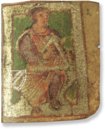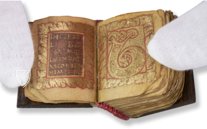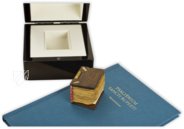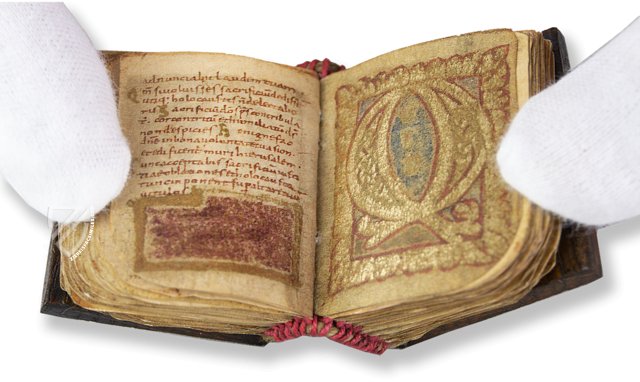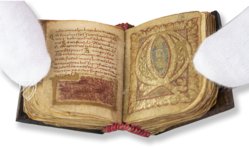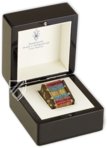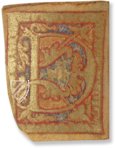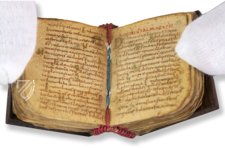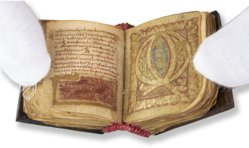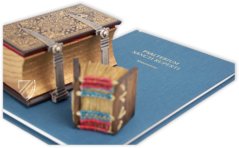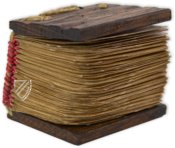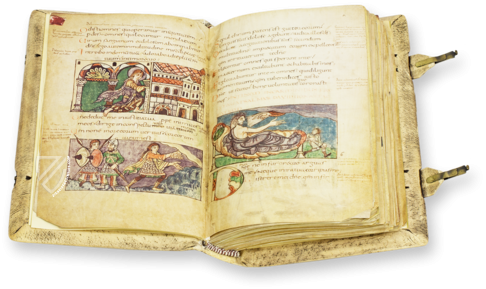Psalterium Sancti Ruperti
(1,000€ - 3,000€)
The smallest facsimile in the world, now possible with new technological innovations and some of the most experienced hands in the industry! With pages measuring only 37 x 31 mm, Psalterium Sancti Ruperti from the library foundation of St. Peter in Salzburg is a gem of illumination that is not much bigger than an actual gemstone. Most likely written in the third-quarter of the 9th century in north-eastern France, it resides today in the oldest library in Austria. Thanks to the skilled hand of some anonymous scribes, the text of the tiny manuscript is incredibly legible. Additionally, its early medieval binding is unique and consists of an open book spine of the codex, whereby the two trusses with booklet seams and also two headbands are left visible. The occasional use of gold ink and purple backgrounds indicates that the psalter was created for a royal of some kind.
Psalterium Sancti Ruperti
How small can a book be so that one is still able to read it? In this day and age of computer-aided design in printing technology, the creation of such a work is no longer unattainable. However, imagine, if you would, that one must write a legible text on pages only the size of a matchbox – by hand! Such a feat nowadays seems to us to be almost impossible. Nevertheless, we find a codex amongst the stock of hand-written library codices whose greatness lies in how unimaginably diminutive it is: One of these precious rarities is the Psalterium Sancti Ruperti from the library foundation of St. Peter in Salzburg. The minuteness of this unique Codex is utterly breathtaking: with pages only 37 x 31 mm in size – the face of the text was required to be precisely 33 x 25 mm and composed of 18 lines. The exquisite legibility of the text with a font size of 1.5mm and a maximal line-spacing of only 1.2mm, bears testimony to the masterful strokes of the unbeknownst scribes.
Roots in the 7th Century
The Psalterium Sancti Ruperti, rests today in the oldest library on Austrian soil, founded in the 8th century. The manuscript was most likely written in the third-quarter of the 9th century in north-eastern France. The note of possession from the 15th century Manuale psalterii sancti Rudberti episcopi, found on the first page of the codex, is the earliest evidence that the manuscript was the rightful property of St. Peter's Abbey Salzburg. Therefore, no connection can be made between the manuscript and Saint Rupert, who in 696 founded the oldest monastery in German-speaking world. In Image 2r, a portrait of King David with his harp (most likely a Psalterium) is featured. Of course, this Carolingian psalter also includes the Incipit Beatus vir-Initial in gold ink against a crimson background. Rubricated Titles in Capitalis Rustica font and golden capital letters make the start of the prayers and verses easily recognizable. The sections of text written in gold against a crimson background as well as the gold initials found in Psalms 1, 51 and 101 lead us to believe that the customer of this magnificent manuscript probably came from royal surroundings. The body of text was written down in Carolingian minuscule.
An Unusual Binding
A special book binding feature is the open book spine of the codex, whereby the two trusses with booklet seams and also two headbands are left visible. The rare binding of this manuscript dates back to the late middle-ages. Up until now, no other early middle-age codex with the aforementioned presentation has been found – therefore this Psalter is an absolute unique specimen of early middle-age book production.
Content
One opens the tiny manuscript to find two prefaces: the introduction by Saint Jerome from the edition of his Gallicanum and the prologue “Origo prophetiae Regis David”, which explains the development of the Psalms. There is much to indicate that this minuscule Psalter was made for practical use and not as a status symbol and the abundant signs of handling evidence its frequent usage. It is indeed plausible that the owner of this miniature Psalter wanted to carry with him this little remembrance book at all times.
The World’s Smallest Facsimile
No publisher has dared to produce so small a manuscript in the form of a facsimile until now: in order to meet the standards of a true-to-original reproduction, new manufacturing processes needed to be conceived, as well as costly and expensive adaptations for radiographic technology developed. The extreme care required during the handling of the small pages and book covers was a special challenge for the bookbinders. With the aid of a special custom-built book binding apparatus, the book binder had to use painstaking care and accuracy to sew layer upon layer together with two trusses to the book block. The work of fastening the two wooden book covers is performed on a scale of mere millimeters, the most important requirement for which is the highest possible degree of concentration and years of experience in the art of book binding. As a result of this highly skilled and professional work, we are able to present to you the smallest facsimile in the world.
Codicology
- Alternative Titles
- Il Salterio di San Ruperto
Psalter des Heiligen Rupert - Size / Format
- 234 pages / 3.7 × 3.1 cm
- Origin
- France
- Date
- 3rd quarter of the 9th century
- Epochs
- Style
- Genre
- Language
- Script
- Carolingian minuscule Rustic capitals
- Illustrations
- A full-page portrait of the author King David, full-page initials at the beginning of Psalms 1, 51 and 101, text pages on ornamental purple ground and golden capital letters on almost every page
- Content
- Book of Psalms
Psalterium Sancti Ruperti
Decorative “D” Initial
This tiny golden “D” is over 1,100 years old and has certainly deteriorated over time, but the blue and red pigments are still discernable, particularly the reds which outline and so wonderfully contrast with the gold. On the other hand, the gold leaf has survived in remarkably good condition and still maintains its original luster – it is truly the most eternal of substances. Leafy tendrils intertwine themselves with the initial itself and come into the corners with three-pointed leaves.
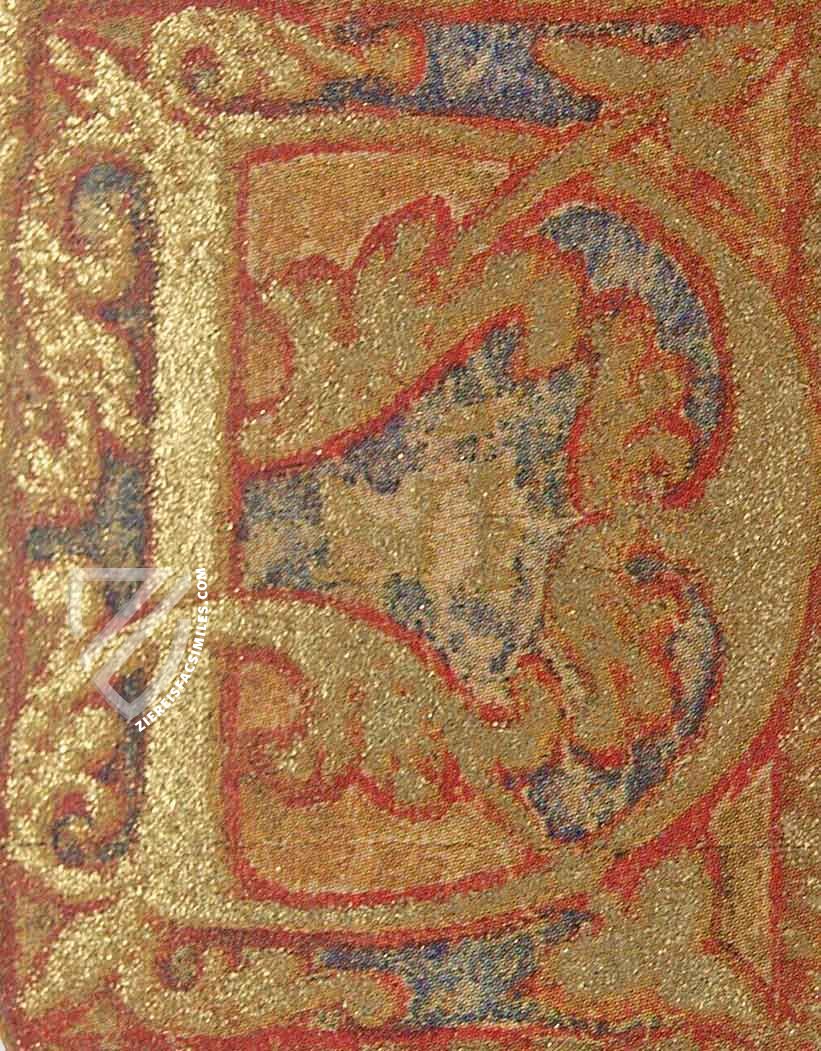
Psalterium Sancti Ruperti
Portrait of King David
One of the tiniest miniatures in all of medieval illumination measures only 3.7 x 3.1 cm. Despite its size and the fact that it is nearly 1,200-years-old, this portrait of King David has survived in surprisingly good condition, which reveals the skill of the anonymous master who created it in a style clearly influenced by Late Antiquity.
This is a miniature in the strictest meaning of the word and is a remarkable work of art consisting of crimson and green paint with plenty of gold leaf. King David, one of the most popular biblical figures of the Middle Ages, is depicted here with his signature lyre. The King of Israel’s head and feet exceed the frame, giving the impression that David is coming out of the page and making this a tiny yet surprisingly dynamic image.

#1 Das Psalterium Sancti Ruperti (Normal Edition)
Language: German
(1,000€ - 3,000€)
#2 Das Psalterium Sancti Ruperti (Luxury Edition)
Language: German
(1,000€ - 3,000€)
- Treatises / Secular Books
- Apocalypses / Beatus
- Astronomy / Astrology
- Bestiaries
- Bibles / Gospels
- Chronicles / History / Law
- Geography / Maps
- Saints' Lives
- Islam / Oriental
- Judaism / Hebrew
- Single Leaf Collections
- Leonardo da Vinci
- Literature / Poetry
- Liturgical Manuscripts
- Medicine / Botany / Alchemy
- Music
- Mythology / Prophecies
- Psalters
- Other Religious Books
- Games / Hunting
- Private Devotion Books
- Other Genres
- Afghanistan
- Armenia
- Austria
- Belgium
- Belize
- Bosnia and Herzegovina
- China
- Colombia
- Costa Rica
- Croatia
- Cyprus
- Czech Republic
- Denmark
- Egypt
- El Salvador
- Ethiopia
- France
- Germany
- Greece
- Guatemala
- Honduras
- Hungary
- India
- Iran
- Iraq
- Israel
- Italy
- Japan
- Jordan
- Kazakhstan
- Kyrgyzstan
- Lebanon
- Liechtenstein
- Luxembourg
- Mexico
- Morocco
- Netherlands
- Palestine
- Panama
- Peru
- Poland
- Portugal
- Romania
- Russia
- Serbia
- Spain
- Sri Lanka
- Sweden
- Switzerland
- Syria
- Tajikistan
- Turkey
- Turkmenistan
- Ukraine
- United Kingdom
- United States
- Uzbekistan
- Vatican City
- A. Oosthoek, van Holkema & Warendorf
- Aboca Museum
- Ajuntament de Valencia
- Akademie Verlag
- Akademische Druck- u. Verlagsanstalt (ADEVA)
- Aldo Ausilio Editore - Bottega d’Erasmo
- Alecto Historical Editions
- Alkuin Verlag
- Almqvist & Wiksell
- Amilcare Pizzi
- Andreas & Andreas Verlagsbuchhandlung
- Archa 90
- Archiv Verlag
- Archivi Edizioni
- Arnold Verlag
- ARS
- Ars Magna
- ArtCodex
- AyN Ediciones
- Azimuth Editions
- Badenia Verlag
- Bärenreiter-Verlag
- Belser Verlag
- Belser Verlag / WK Wertkontor
- Benziger Verlag
- Bernardinum Wydawnictwo
- BiblioGemma
- Biblioteca Apostolica Vaticana (Vaticanstadt, Vaticanstadt)
- Bibliotheca Palatina Faksimile Verlag
- Bibliotheca Rara
- Boydell & Brewer
- Bramante Edizioni
- Bredius Genootschap
- Brepols Publishers
- British Library
- C. Weckesser
- Caixa Catalunya
- Canesi
- CAPSA, Ars Scriptoria
- Caratzas Brothers, Publishers
- Carus Verlag
- Casamassima Libri
- Centrum Cartographie Verlag GmbH
- Chavane Verlag
- Christian Brandstätter Verlag
- Circulo Cientifico
- Club Bibliófilo Versol
- Club du Livre
- CM Editores
- Collegium Graphicum
- Collezione Apocrifa Da Vinci
- Comissão Nacional para as Comemorações dos Descobrimentos Portugueses
- Coron Verlag
- Corvina
- CTHS
- D. S. Brewer
- Damon
- De Agostini/UTET
- De Nederlandsche Boekhandel
- De Schutter
- Deuschle & Stemmle
- Deutscher Verlag für Kunstwissenschaft
- DIAMM
- Droz
- E. Schreiber Graphische Kunstanstalten
- Ediciones Boreal
- Ediciones Grial
- Ediclube
- Edições Inapa
- Edilan
- Editalia
- Edition Deuschle
- Edition Georg Popp
- Edition Leipzig
- Edition Libri Illustri
- Editiones Reales Sitios S. L.
- Éditions de l'Oiseau Lyre
- Editions Medicina Rara
- Editorial Casariego
- Editorial Mintzoa
- Editrice Antenore
- Editrice Velar
- Edizioni Edison
- Egeria, S.L.
- Eikon Editores
- Electa
- Emery Walker Limited
- Enciclopèdia Catalana
- Eos-Verlag
- Ephesus Publishing
- Ernst Battenberg
- Eugrammia Press
- Extraordinary Editions
- Fackelverlag
- Facsimila Art & Edition
- Facsimile Editions Ltd.
- Facsimilia Art & Edition Ebert KG
- Faksimile Verlag
- Feuermann Verlag
- Folger Shakespeare Library
- Franco Cosimo Panini Editore
- Friedrich Wittig Verlag
- Fundación Hullera Vasco-Leonesa
- G. Braziller
- Gabriele Mazzotta Editore
- Gebr. Mann Verlag
- Gesellschaft für graphische Industrie
- Getty Research Institute
- Giovanni Domenico de Rossi
- Giunti Editore
- Graffiti
- Grafica European Center of Fine Arts
- Guido Pressler
- Guillermo Blazquez
- Gustav Kiepenheuer
- H. N. Abrams
- Harrassowitz
- Harvard University Press
- Helikon
- Hendrickson Publishers
- Henning Oppermann
- Herder Verlag
- Hes & De Graaf Publishers
- Hoepli
- Holbein-Verlag
- Houghton Library
- Hugo Schmidt Verlag
- Idion Verlag
- Il Bulino, edizioni d'arte
- ILte
- Imago
- Insel Verlag
- Insel-Verlag Anton Kippenberger
- Instituto de Estudios Altoaragoneses
- Instituto Nacional de Antropología e Historia
- Istituto dell'Enciclopedia Italiana - Treccani
- Istituto Ellenico di Studi Bizantini e Postbizantini
- Istituto Geografico De Agostini
- Istituto Poligrafico e Zecca dello Stato
- Italarte Art Establishments
- Jan Thorbecke Verlag
- Johnson Reprint Corporation
- Josef Stocker
- Josef Stocker-Schmid
- Jugoslavija
- Karl W. Hiersemann
- Kasper Straube
- Kaydeda Ediciones
- Kindler Verlag / Coron Verlag
- Kodansha International Ltd.
- Konrad Kölbl Verlag
- Kurt Wolff Verlag
- La Liberia dello Stato
- La Linea Editrice
- La Meta Editore
- Lambert Schneider
- Landeskreditbank Baden-Württemberg
- Leo S. Olschki
- Les Incunables
- Liber Artis
- Library of Congress
- Libreria Musicale Italiana
- Lichtdruck
- Lito Immagine Editore
- Lumen Artis
- Lund Humphries
- M. Moleiro Editor
- Maison des Sciences de l'homme et de la société de Poitiers
- Manuscriptum
- Martinus Nijhoff
- Maruzen-Yushodo Co. Ltd.
- MASA
- Massada Publishers
- McGraw-Hill
- Metropolitan Museum of Art
- Militos
- Millennium Liber
- Müller & Schindler
- Nahar - Stavit
- Nahar and Steimatzky
- National Library of Wales
- Neri Pozza
- Nova Charta
- Oceanum Verlag
- Odeon
- Orbis Mediaevalis
- Orbis Pictus
- Österreichische Staatsdruckerei
- Oxford University Press
- Pageant Books
- Parzellers Buchverlag
- Patrimonio Ediciones
- Pattloch Verlag
- PIAF
- Pieper Verlag
- Plon-Nourrit et cie
- Poligrafiche Bolis
- Presses Universitaires de Strasbourg
- Prestel Verlag
- Princeton University Press
- Prisma Verlag
- Priuli & Verlucca, editori
- Pro Sport Verlag
- Propyläen Verlag
- Pytheas Books
- Quaternio Verlag Luzern
- Reales Sitios
- Recht-Verlag
- Reichert Verlag
- Reichsdruckerei
- Reprint Verlag
- Riehn & Reusch
- Roberto Vattori Editore
- Rosenkilde and Bagger
- Roxburghe Club
- Salerno Editrice
- Saltellus Press
- Sandoz
- Sarajevo Svjetlost
- Schöck ArtPrint Kft.
- Schulsinger Brothers
- Scolar Press
- Scrinium
- Scripta Maneant
- Scriptorium
- Shazar
- Siloé, arte y bibliofilia
- SISMEL - Edizioni del Galluzzo
- Sociedad Mexicana de Antropología
- Société des Bibliophiles & Iconophiles de Belgique
- Soncin Publishing
- Sorli Ediciones
- Stainer and Bell
- Studer
- Styria Verlag
- Sumptibus Pragopress
- Szegedi Tudomànyegyetem
- Taberna Libraria
- Tarshish Books
- Taschen
- Tempus Libri
- Testimonio Compañía Editorial
- Thames and Hudson
- The Clear Vue Publishing Partnership Limited
- The Facsimile Codex
- The Folio Society
- The Marquess of Normanby
- The Richard III and Yorkist History Trust
- Tip.Le.Co
- TouchArt
- TREC Publishing House
- TRI Publishing Co.
- Trident Editore
- Typis Regiae Officinae Polygraphicae
- Union Verlag Berlin
- Universidad de Granada
- University of California Press
- University of Chicago Press
- Urs Graf
- Vallecchi
- Van Wijnen
- VCH, Acta Humaniora
- VDI Verlag
- VEB Deutscher Verlag für Musik
- Verlag Anton Pustet / Andreas Verlag
- Verlag Bibliophile Drucke Josef Stocker
- Verlag der Münchner Drucke
- Verlag für Regionalgeschichte
- Verlag Styria
- Vicent Garcia Editores
- W. Turnowski Ltd.
- W. Turnowsky
- Waanders Printers
- Wiener Mechitharisten-Congregation (Wien, Österreich)
- Wissenschaftliche Buchgesellschaft
- Wissenschaftliche Verlagsgesellschaft
- Wydawnictwo Dolnoslaskie
- Xuntanza Editorial
- Zakład Narodowy
- Zollikofer AG






